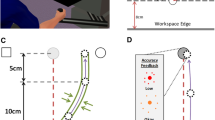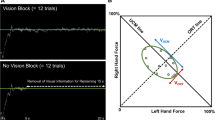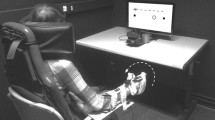Abstract
The present study examines whether non-active older adults are more dependent on visual information when executing aiming movements and whether age-related declines in proprioception play a mediating role herein. Young (N = 40) and older adults (N = 38) were divided into physically active and non-active subgroups based on self-reported sports participation levels. In experiment 1, participants executed wrist-aiming movements with and without visual feedback. In experiment 2, passive proprioceptive acuity was assessed using wrist motion detection and position matching tests. Results showed similar aiming accuracy across age groups both with and without visual feedback, but older adults exhibited longer movement times, prolonged homing-in phase, and made more corrective submovements. Passive proprioceptive acuity was significantly affected by physical activity level and age, with participants in the active group scoring better than their non-active peers. However, these declines did not predict performance changes on the aiming task. Taken together, our observations suggest that decline in proprioceptive acuity did not predict performance changes on the aiming task and older adults were able to compensate for their decreased motion and position sense when allowed sufficient time. In line with these observations, we proposed that older adults are able to compensate for their decline in proprioception by increasing their reliance on predictive models.




Similar content being viewed by others
References
Adamo DE, Alexander NB, Brown SH (2009) The influence of age and physical activity on upper limb proprioceptive ability. J Aging Phys Activ 17:272–293
Adamo DE, Martin BJ, Brown SH (2007) Age-related differences in upper limb proprioceptive acuity. Percept Mot Skills 104:1297–1309
Alaerts K, Levin O, Swinnen SP (2007) Whether feeling or seeing is more accurate depends on tracking direction within the perception-action cycle. Behav Brain Res 178:229–234
Baecke JA, Burema J, Frijters JE (1982) A short questionnaire for the measurement of habitual physical activity in epidemiological studies. Am J Clin Nutr 36:936–942
Benjamini Y, Hochberg Y (1995) Controlling the false discovery rate: a practical and powerful approach to multiple testing. J R Stat Soc Series B (Methodological) 57:289–300
Berchicci M, Lucci G, Perri RL, Spinelli D, Di Russo F (2014) Benefits of physical exercise on basic visuo-motor functions across age. Front Aging Neurosci 6:48
Boisgontier MP, Nougier V (2013) Ageing of internal models: from a continuous to an intermittent proprioceptive control of movement. Age 35:1339–1355
Boisgontier MP, Swinnen SP (2014) Proprioception in the cerebellum. Front Hum Neurosci 8:212
Boisgontier MP, Swinnen SP (2015) Age-related deficit in a bimanual joint position matching task is amplitude dependent. Front Aging Neurosci 7:162
Boisgontier MP, Beets IAM, Duysens I, Nieuwboer A, Krampe RT, Swinnen SP (2013) Age-related differences in attentional cost associated with postural dual tasks: increased recruitment of generic cognitive resources in older adults. Neurosci Biobehav Rev 37:1824–1837
Boisgontier MP, Olivier I, Chenu O, Nougier V (2012) Presbypropria: the effects of physiological ageing on proprioceptive control. Age 34:1179–1194
Boisgontier MP, Van Halewyck F, Corporaal S, Willacker L, Van den Bergh V, Beets IAM, et al. (2014) Vision of the active limb impairs bimanual motor tracking in young and older adults. Front Aging Neurosci 6:320
Boisseau E, Scherzer P, Cohen H (2002) Eye–hand coordination in aging and in Parkinson’s disease. Aging Neuropsychol Cogn 9:266–275
Capranica L, Tessitore A, Olivieri B, Minganti C, Pesce C (2004) Field evaluation of cycled coupled movements of hand and foot in older individuals. Gerontology 50:399–406
Chaput S, Proteau L (1996) Modifications with aging in the role played by vision and proprioception for movement control. Exp Aging Res 22:1–21
Coats RO, Wann JP (2011) The reliance on visual feedback control by older adults is highlighted in tasks requiring precise endpoint placement and precision grip. Exp Brain Res 214:139–150
Cortis C, Tessitore A, Perroni F, Lupo C, Pesce C, Ammendolia A, Capranica L (2009) Interlimb coordination, strength, and power in soccer players across the lifespan. J Strength Cond Res 23:2458–2466
Curran-Everett D (2000) Multiple comparisons: philosophies and illustrations. Am J Physiol Regul Integr Comp Physiol 279:R1–R8
Elliott D, Hansen S, Grierson LE, Lyons J, Bennett SJ, Hayes SJ (2010) Goal-directed aiming: two components but multiple processes. Psychol Bull 136:1023–1044
Folstein MF, Folstein SE, McHugh PR (1975) “Mini-mental state” A Practical Method for Grading the Cognitive State of Patients for the. Clinician J Psychiatr Res 12:189–198
Genovese CR, Lazar NA, Nichols T (2002) Thresholding of statistical maps in functional neuroimaging using the false discovery rate. NeuroImage 15:870–878
Ghez C, Gordon J, Ghilardi MF (1995) Impairments of reaching movements in patients without proprioception: II Effects of Visual Information on Accuracy. J Neurophysiol 73:361–372
Goble DJ, Coxon JP, Wenderoth N, Van Impe A, Swinnen SP (2009) Proprioceptive sensibility in the elderly: Degeneration, functional consequences and plastic-adaptive processes. Neurosci Biobehav Rev 33:271–278
Heath M (2005) Role of limb and target vision in the online control of memory-guided reaches. Mot Control 9:281–311
Herter TM, Scott SH, Dukelow SP (2014) Systematic changes in position sense accompany normal aging across adulthood. J Neuroeng Rehabil 11:1–12
Hertogh EM, Monninkhof EM, Schouten EG, Peeters PH, Schuit AJ (2008) Validity of the modified Baecke questionnaire: comparison with energy expenditure according to the doubly labeled water method. Int J Behav Nutr Phys Act 5:30
Jacobs HI, Leritz EC, Williams VJ, Van Boxtel MP, Elst WV, Jolles J, et al. (2011) Association betweenwhite matter microstructure, executive functions, and processing speed inolder adults: the impact of vascular health. Hum Brain Mapp 34:77–95
Kalisch T, Kattenstroth JC, Kowalewski R, Tegenthoff M, Dinse HR (2012) Age-related changes in the joint position sense of the human hand. Clin Interv Aging 7:499–507
Ketcham CJ, Seidler RD, Van Gemmert AW, Stelmach GE (2002) Age-related kinematic differences as influenced by task difficulty, target size, and movement amplitude. J Gerontol B Psychol Sci Soc Sci 57:54–64
Khan MA, Elliott D, Coull J, Chua R, Lyons J (2002) Optimal control strategies under different feedback schedules: kinematic evidence. J Mot Behav 34:45–57
Khan MA, Franks IM, Elliott D, Lawrence GP, Chua R, Bernier PM, et al. (2006) Inferring online and offline processing of visual feedback in target-directed movements from kinematic data. Neurosci Biobehav Rev 30:1106–1121
Khan MA, Franks IM, Goodman D (1998) The effect of practice on the control of rapid aiming movements: evidence for an independency between programming and feedback processing. Q J Exp Psychol 51:425–444
Kokmen E, Bossemeyer RWJ, Williams WJ (1978) Quantitative evaluation of joint motion sensation in an aging population. Gerontology 33:62–67
Lavrysen A, Elliott D, Buekers MJ, Feys P, Helsen WF (2007) Eye–hand coordination asymmetries in manual aiming. J Mot Behav 39:9–18
Lavrysen A, Heremans E, Peeters R, Wenderoth N, Feys P, Swinnen SP, et al. (2012) Hemispheric asymmetries in goal-directed hand movements are independent of hand preference. NeuroImage 62:1815–1824
Lavrysen A, Heremans E, Peeters R, Wenderoth N, Helsen WF, Feys P, et al. (2008) Hemispheric asymmetries in eye–hand coordination. NeuroImage 39:1938–1949
Lyons J, Elliott D, Swanson LR, Chua R (1996) Use of vision in manual aiming by young and older adults. J Aging Phys Act 4:165–178
Mathiowetz V, Volland G, Kashman N, Weber K (1985) Adult norms for the Box and block test of manual dexterity. Am J Occup Ther 39:386–391
McGregor KM, Zlatar Z, Kleim E, Sudhyadhom A, Bauer A, Phan S, et al. (2011) Physical activity and neural correlates of aging: a combined TMS/fMRI study. Behav Brain Res 222:158–168
Muions M, Ballesteros S (2014) Peripheral vision and perceptual asymmetries in young and older martial arts athletes and nonathletes. Atten Percept Psychophys 76:2465–2476
Muions M, Ballesteros M, Ballesteros S (2015) Sports can protect dynamic visual acuity from aging: a study with young and older judo and karate martial arts athletes. Atten Percept Psychophys 77:2061–2073
Mustelin L, Latvala A, Pietiläinen KH, Piirilä P, Sovijärvi AR, Kujala UM, et al. (2011) Associations between sports participation, cardiorespiratory fitness, and adiposity in young adult twins. J Appl Physiol 110:681–686
Nagamatsu LS, Handy TC, Hsu CL, Voss M, Liu-Ambrose T (2012) Resistance training promotes cognitive and functional brain plasticity in seniors with probable mild cognitive impairment. Arch Intern Med 172:666–668
Oldfield RC (1971) The assessment and analysis of handedness: the Edinburgh inventory. Neuropsychologia 9:97–113
Oxford Grice K, Vogel KA, Le V, Mitchell A, Muniz S, Vollmer MA (2003) Adult norms for a commercially available Nine Hole Peg test for finger dexterity. Am J Occup Ther 57:570–573
Petrella RJ, Lattanzio PJ, Nelson MG (1997) Effect of age and activity on knee proprioception. Am J Phys Med Rehabil 76:235–241
Pickard CM, Sullivan PE, Allison GT, Singer KP (2003) Is there a difference in hip joint position sense between young and older groups? J Gerontol A Biol Sci Med Sci 58:631–635
Pratt J, Chasteen AL, Abrams RA (1994) Rapid aimed limb movements: age differences and practice effects in component submovements. Psychol Aging 9:325–334
Proske U, Gandevia SC (2012) The proprioceptive senses: their roles in signaling body shape, body position and movement, and muscle force. Physiol Rev 92:1651–1697
Rand MK, Stelmach GE (2011) Adaptation of gaze anchoring through practice in young and older adults. Neurosci Lett 492:47–51
Saunders JA, Knill DC (2003) Humans use continuous visual feedback from the hand to control fast reaching movements. Exp Brain Res 152:341–352
Seidler-Dobrin RD, Stelmach GE (1998) Persistence in visual feedback control by the elderly. Exp Brain Res 119:467–474
Sherrington CS (1907) On the proprioceptive system, especially in its reflex aspect. Brain 29:467–482
Smith JC, Nielson KA, Woodard JL, Seidenberg M, Durgerian S, Antuono P, et al. (2011) Interactive effects ofphysical activity and APOE-epsilon 4 on BOLD semantic memory activation inhealthy elders. NeuroImage 54:635–644
Stelmach GE, Goggin NL, Amrhein PC (1988) Aging and the restructuring of precued movements. Psychol Aging 3:151–157
Temprado JJ, Sleimen-Malkoun R, Lemaire P, Rey-Robert B, Retornaz F, Berton E (2013) Aging of sensorimotor processes: asystematic study in Fitts’ task. Exp Brain Res 228:105–116
Terrier R, Forestier N, Berrigan F, Germain-Robitaille M, Lavalliere M, Teasdale N (2011) Effect of terminal accuracy requirements on temporal gaze-hand coordination during fast discrete and reciprocal pointings. J Neuroeng Rehabil 8:10
Van Halewyck F, Lavrysen A, Levin O, Boisgontier MP, Elliott D, Helsen WF (2015b) Factors underlying age-related changes in discrete aiming. Expl Brain Res 233:1733–1744
Van Halewyck F, Lavrysen A, Levin O, Elliott D, Helsen WF (2015a) The impact of age and physical activity level on manual aiming performance. J Aging Phys Act 23:169–179
Van Halewyck F, Lavrysen A, Levin O, Boisgontier MP, Elliott D, Helsen WF (2014) Both age and physical activity level impact on eye-hand coordination. Hum Mov Sci 36:80–96
Voelcker-Rehage C, Niemann C (2013) Structural and functional brain changes related to different types of physicalactivity across the life span. Neurosci Biobehav Rev 37:2268–2295
Voelcker-Rehage C, Godde B, Staudinger UM (2011) Cardiovascular and coordination training differentially improve cognitive performance and neuralprocessing in older adults. Front Hum Neurosci 5:26
Voorrips LE, Ravelli AC, Dongelmans PC, Deurenberg P, Van Staveren WA (1991) A physical activity questionnaire for the elderly. Med Sci Sports Exerc 23:974–979
Wechsler D (1997) Technical manual for the Wechsler adult Intelligence test –, Third edn. San Antonio Psychological Corporation, San Antonio
Weinstein S (1993) Fifty years of somatosensory research: from the semmes-weinstein monofilaments to weinstein enhanced sensory test. J Hand Ther 6:11–22
Welsh TN, Higgins L, Elliott D (2007) Are there age-related differences in learning to optimize speed, accuracy, and energy expenditure? Hum Mov Sci 26:892–912
Woodworth RS (1899) The accuracy of voluntary movement. Psychol Rev 3:1–119
Wright ML, Adamo DE, Brown SH (2011) Age-related declines in the detection of passive wrist movement. Neurosci Lett 500:108–112
Acknowledgments
Werner F. Helsen and Florian Van Halewyck would like to acknowledge the KU Leuven Research Council for financially supporting this research project. Matthieu P. Boisgontier is supported by a research grant (1504015N) and a post-doctoral fellowship of the Research Foundation—Flanders (FWO). The authors also wish to thank Ig. Marc Beirinckx and Ig. Paul Meugens for providing invaluable guidance in designing the research equipment.
Author information
Authors and Affiliations
Corresponding author
Ethics declarations
Conflict of interest
The authors declare that they have no conflict of interest.
Electronic supplementary material
ESM 1
(DOCX 61 kb)
About this article
Cite this article
Helsen, W.F., Van Halewyck, F., Levin, O. et al. Manual aiming in healthy aging: does proprioceptive acuity make the difference?. AGE 38, 45 (2016). https://doi.org/10.1007/s11357-016-9908-z
Received:
Accepted:
Published:
DOI: https://doi.org/10.1007/s11357-016-9908-z




